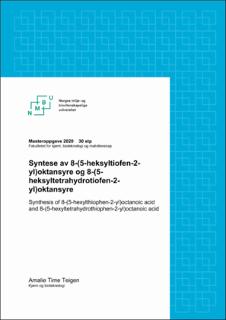| dc.contributor.advisor | Stenstrøm, Yngve | |
| dc.contributor.advisor | Antonsen, Simen | |
| dc.contributor.author | Teigen, Amalie Time | |
| dc.date.accessioned | 2020-09-30T11:39:30Z | |
| dc.date.available | 2020-09-30T11:39:30Z | |
| dc.date.issued | 2020 | |
| dc.identifier.uri | https://hdl.handle.net/11250/2680514 | |
| dc.description.abstract | I denne oppgaven skulle to mulige synteser av 8-(5-heksyltiofen-2-yl)oktansyre (2) og tre mulige synteser av 8-(5-heksyltetrahydrotiofen-2-yl)oktansyre (3) bli testet.
To av strategiene tok utgangspunkt i å først syntetisere 8-(5-heksyltiofen-2-yl)oktansyre (2) for deretter å redusere denne til 8-(5-heksyltetrahydrotiofen-2-yl)oktansyre (3).
Den første strategien benytter 2-brom-5-heksyltiofen (30) og 7-oktyn-1-ol (31) som startmaterialer. Det ble først syntetisert 2-oktyn-1-ol via alkylering av 1-brompentan og propargylalkohol. Deretter ble 7-oktyn-1-ol (31) omdannet fra 2-oktyn-1-ol via zipperreaksjon. Flere metoder ble testet, men kun middels/dårlige utbytter ble oppnådd (30-40 %). Syntesen av 2- heksyltiofen ble utført via alkylering av tiofen og 1-bromheksan. Denne ble prøvd å syntetiseres videre til 2-brom-5- heksyltiofen (30). 2-brom-5-heksyltiofen skulle deretter omdannes til 8-(5-heksyltiofen-2-yl)oktansyre (2), som skulle reduseres til 8-(5- heksyltetrahydrotiofen-2-yl)oktansyre (3). Siden tiden ikke strakk til kom ikke syntesen av 8-(5- heksyltiofen-2-yl)oktansyre (2) og 8-(5-heksyltetrahydrotiofen-2-yl)oktansyre (3) i mål.
I den andre strategien skulle det benyttes 5-heksyltiofen-2-karbaldehyd (33) og metyl-7-(trifenylfosfanyliden)heptanat (34) som startmaterialer. Det skulle også her syntetiseres 8-(5-heksyltiofen-2-yl)oktansyre (2) som skulle reduseres til 8-(5-heksyltetrahydrotiofen-2-yl)oktansyre (3).
I den tredje strategien skulle det benyttes 2-heksyl-2,5-dihydrotiofen-1,1-dioksid (40) og metyl-6-jodheksanat (41) som startmaterialer for å syntetisere 8-(5-heksyltetrahydrotiofen-2- yl)oktansyre (3).
På grunn av koronaviruset og situasjonen som oppstod var det bare mulig å utføre en del av det praktiske arbeidet på laboratoriet. Dermed er syntesene som ikke var mulig å utføre på laboratoriet basert på rapporterte studier og lignende synteser. Disse er vedlagt til slutt i denne oppgaven. | en_US |
| dc.description.abstract | In this thesis, two strategies of 8-(5-hexylthiophen-2-yl) octanoic acid (2) and three strategies of 8-(5-hexyltetrahydrothiophen-2-yl) octanoic acid (3) were to be tested.
Two of these were based on first synthesizing 8-(5-hexylthiophen-2-yl) octanoic acid (2) and then reducing it to 8-(5-hexyltetrahydrothiophen-2-yl) octanoic acid (3).
The first strategy uses 2-bromo-5-hexylthiophene (30) and 7-octyn-1-ol (31) as starting materials. The alkyne 2-octyn-1-ol was synthesized via alkylation of 1-bromopentane and propargyl alcohol. Then, 7-octyn-1-ol (31) was prepared from 2-octyn-1-ol via zipper reaction. Different literature procedures were tested, but only poor to moderate yields (30-40 %) were obtained. The synthesis of 2-hexylthiophene was carried out via alkylation of thiophene and 1-bromohexane. This was attempted to be further converted to 2-bromo-5-hexylthiophene (30). 2-bromo-5-hexylthiophene (30) was to be converted to 8-(5-hexylthiophen-2-yl) octanoic acid (2). This was to be reduced to 8-(5-hexyltetrahydrothiophen-2-yl) octanoic acid (3) thereafter. Due to lack of time, the final steps toward 8-(5- hexylthiophen-2-yl) octanoic acid (2) and 8-(5-hexyltetrahydrothiophen-2-yl) octanoic acid (3) remain to be done.
In the second strategy, 5-hexylthiophen-2-carbaldehyde (33) and methyl 7-(triphenylphosphanyliden) heptanate (34) were to be used as starting materials. The same intermediate as above, 8-(5-hexylthiophen-2-yl) octanoic acid (2), was to be prepared, and then converted to 8-(5-hexyltetrahydrothiophen-2-yl) octanoic acid (3).
In the third strategy, 2-hexyl-2,5-dihydrothiophen-1,1-dioxide (40) and methyl-6-iodohexanate (41) were to be used as starting materials to synthesize 8-(5-hexyltetrahydrothiophen-2-yl) octanoic acid (3).
Due to the coronavirus and the situation that arose it was only possible to perform part of the practical work in the laboratory. Thus, the syntheses that were not possible to perform in the laboratory are based on reported studies and similar syntheses. These are included as attachments | en_US |
| dc.language.iso | nob | en_US |
| dc.publisher | Norwegian University of Life Sciences, Ås | en_US |
| dc.rights | Attribution-NonCommercial-NoDerivatives 4.0 Internasjonal | * |
| dc.rights.uri | http://creativecommons.org/licenses/by-nc-nd/4.0/deed.no | * |
| dc.subject | Organisk kjemi | en_US |
| dc.title | Syntese av 8-(5-heksyltiofen-2-yl)oktansyre og 8-(5-heksyltetrahydrotiofen-2-yl)oktansyre | en_US |
| dc.title.alternative | Synthesis of 8-(5-hexylthiophen-2-yl)octanoic acid and 8-(5-hexyltetrahydrothiophen-2-yl)octanoic acid | en_US |
| dc.type | Master thesis | en_US |
| dc.description.localcode | M-KB | en_US |

